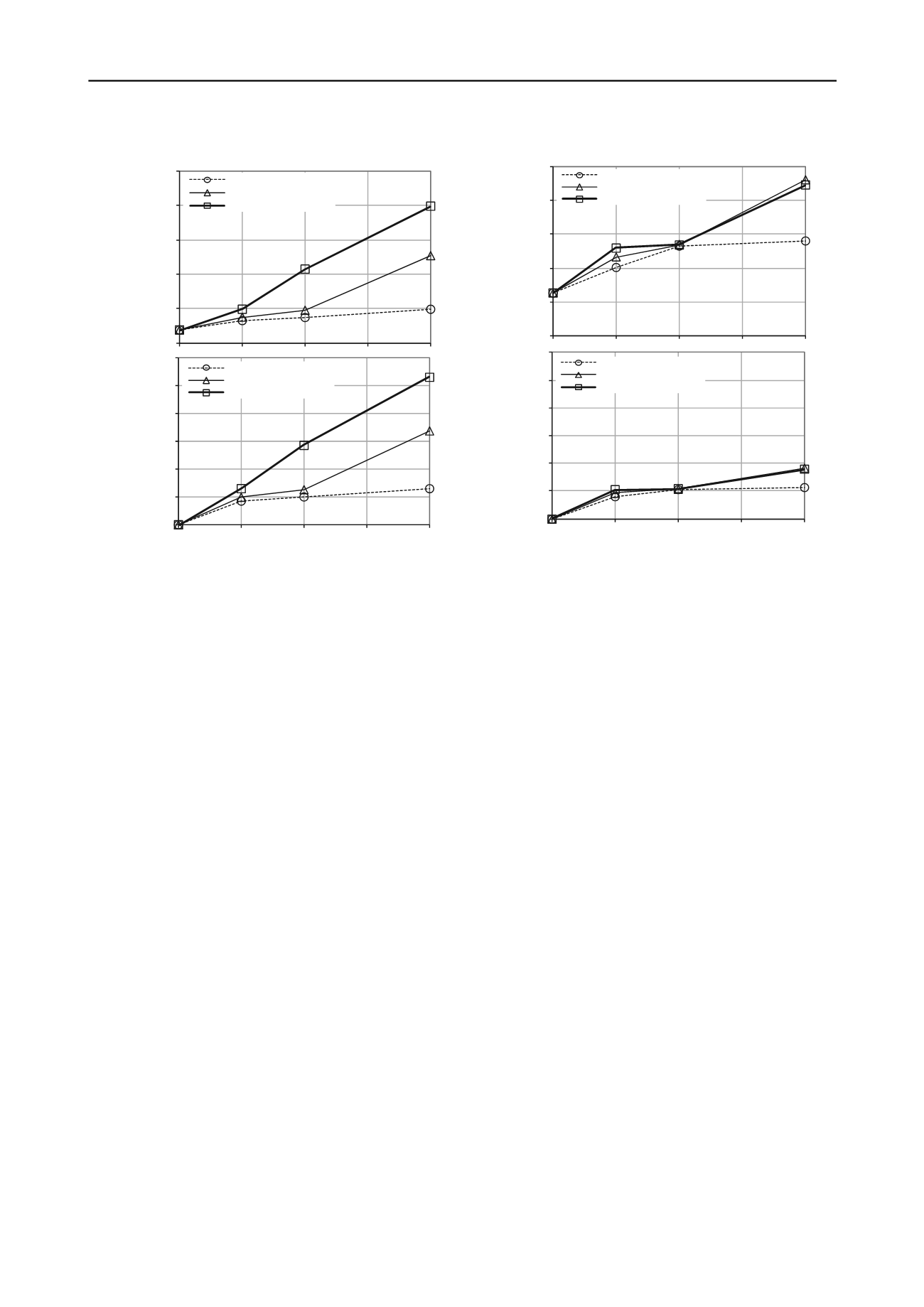
2596
Proceedings of the 18
th
International Conference on Soil Mechanics and Geotechnical Engineering, Paris 2013
Figure 4. Improvement in UCS for cement content of 0.5%.
3.5
Effect of Cement Content on UCS
The range of the cement content that was chosen in this study
(0.5% to 1.0%) is indicative of lightly-cemented sands.
However, the results presented in Figs. 2 to 5 indicate a clear
difference in the performance of the composite specimens that
were stabilized with 0.5% cement and specimens stabilized with
1.0%, particularly with regards to the contribution of the fibers
to the improved compressive strength.
For specimens that were not reinforced with fibers, the
increase in cement content from 0.5% to 1.0% increased the
unconfined compressive strength from 15 kPa to 50 kPa. With
the addition of fibers, results showed that the UCS could be
improved by more than 10 times for a cement content of 0.5%
but only to 3.7 times for the cement content of 1.0%, indicating
a decreased relative efficiency of the fibers at improving the
compressive strength as the cement ratio increases.
It should be noted however that the actual maximum value
(largest fiber content and fiber length) of the unconfined
compressive strength was still higher (about 185 kPa) for the
cement content of 1.0% compared to the maximum value (159
kPa) measured for the cement content of 0.5%. For the smaller
fiber contents and fiber lengths, the values of the UCS for the
cement content of 1% were all higher than those of the 0.5% at
the same fiber content and fiber length, indicating that the
magnitude of the improved UCS was larger for the higher
cement content.
4 CONCLUSION
Based on the results of 20 unconfined compression tests that
were conducted in this study on fiber-reinforced lightly-
cemented sands, the following conclusions can be drawn:
1. The behavior of specimens with higher cement contents is
more brittle compared to specimens with lower cement
contents. However, brittleness decreased with the
inclusion of fibers and the energy absorption capacity
increased as the fiber content and length increased.
2. For the smaller cement content, the stiffness of the
specimens was not affected by the addition of fibers,
except for the cases of 20mm fibers with fiber contents
0
40
80
120
160
200
0.00
0.25
0.50
0.75
1.00
UnconfinedCompressive Strength (kPa)
Fiber Content, FC (%)
Cement Content = 1.0%
Fiber Length = 6mm
Fiber Length = 12mm
Fiber Length = 20mm
0
2
4
6
8
10
12
0.00
0.25
0.50
0.75
1.00
UCS (Fibers) / UCS (No Fibers)
Fiber Content, FC (%)
Fiber Length = 6mm
Fiber Length = 12mm
Fiber Length = 20mm
0
40
80
120
160
200
0.00
0.25
0.50
0.75
1.00
UnconfinedCompressive Strength (kPa)
Fiber Content, FC (%)
Cement Content = 0.5%
Fiber Length =6mm
Fiber Length =12mm
Fiber Length =20mm
0
2
4
6
8
10
12
0.00
0.25
0.50
0.75
1.00
UCS (Fibers) / UCS (No Fibers)
Fiber Content, FC (%)
Fiber Length =6mm
Fiber Length =12mm
Fiber Length =20mm
Figure 5. Improvement in UCS for cement content of 1.0%.
of 0.25% and 0.50%, where the stiffness was found to be
improved. For the higher cement content fibers could
result in a softer initial response particularly for higher
fiber contents and longer fibers.
3. For the both cement contents used, results indicated a
consistent increase in the unconfined compressive
strength with fiber content. The cement content played a
significant role in defining the improvement ratio of the
UCS, with the ratio varying from 2 (smallest fiber
content and fiber length) to 10 (largest fiber content and
fiber length) for a cement ratio of 0.5%, and from about
2 to 4 for the larger cement ratio of 1.0%.
4. For a cement content of 0.5%, as the fiber length
increased, the UCS increased and the strain at failure
increased, indicating improved ductility, with the effect
of fiber length being evident at higher fiber contents
compared to lower fiber contents. For the larger cement
content of 1.0%, the effect of fiber length on the
unconfined compressive strength was less significant.
5 ACKNOWLEDGEMENTS
The authors would like to acknowledge the support of the
Lebanese National Council for Scientific Research (LNCSR)
for funding this research program.
6 REFERENCES
Maher M.H. and Ho Y.C. 1993. Behavior of fiber-reinforced cemented
sand under static and cyclic loads.
American Society for Testing
and Materials
16, 330-338.
Kaniraj S.R. and Havanagi V.G. 2001. Behavior of cement-stabilized
fiber-reinforced fly ash-soil mixtures.
Journal of Geotechnical
Engineering
127, 574-584.
Consoli et. al. 1998. Influence of fiber and cement addition on behavior
of sandy soil.
Journal of Geotechnical Engineering
124, 1211-1214.
Consoli et. al. 2002. Engineering behavior of a sand reinforced with
plastic waste.
Journal of Geotechnical Engineering
128, 462- 472.
Sobhan K. and Mashnad M. 2002. Tensile strength and toughness of
soil-cement-fly-ash composite reinforced with recycled high-
density polyethylene strips.
Journal of Materials in Civil
Engineering
14, 177-184.


